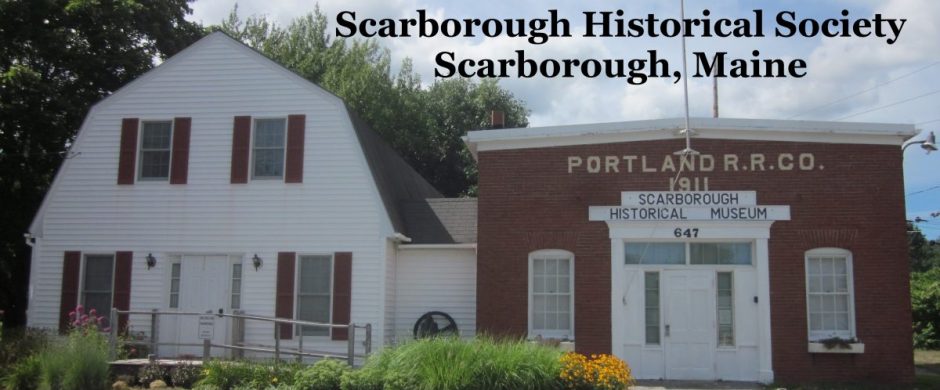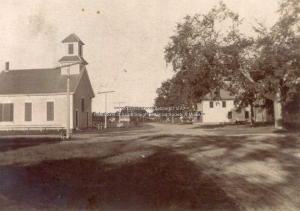Text by Bruce Thurlow
Images from Scarborough Historical Society and Charlene Fenlason
The first “roads” were not really roads but Indian footpaths through the woods. Generally, the trails followed firm ground rather than a direct course, avoiding swamps and hills whenever possible. Certain signs cut on trees marked paths from one home to another; and if marks were cut just right, the traveler could find his way after dark. Later, branches and trees were cleared from the paths to allow passage for horses. As the settlements grew, attention was given to roads and ferries. In 1658, the Massachusetts court passed an ordinance requiring ferries for transport across rivers. A ferry was established on the Spurwink River, and Ambrose Boaden was the first ferryman.(1) Around 1673 the town was ordered to have good and sufficient means to transport horses. Another ferry was established at a place still called Ferry Beach, located near Black Rocks off the Black Point Road. It was part of the first King’s Highway.
The first King’s Highway had two rows of cartwheel ruts with a footpath in the middle. It wasn’t smooth and straight, but it was much wider than footpaths and much easier to follow. Since there were no bridges, brooks and rivers were crossed at wading places or by ferry. By 1653, the King’s Highway reached from Portland to Kittery and followed Scarborough’s coastline. At Scarborough, the highway began at the Spurwink River where a traveler would take the ferry across the river, and then at Higgins Beach horses could run along the hard sand. The highway continued to the ferry at Ferry Beach; and from the ferry landing at Pine Point, the traveler would proceed on the beach to Old Orchard. For more than one hundred years, the King’s Highway was the only land route between the Province of Maine and Massachusetts.(2)
A post rider could ride 30 miles on a clear summer day; but in stormy winter or foggy spring weather, he could ride only a few miles a day. So around 1740, the upper King’s Highway was built further inland as part of a plan to improve postal service, and the coastal King’s Highway was not used as often. In 1753, the British Government named Benjamin Franklin as one of two deputies in charge of the colonial mail system. To overcome colonists’ suspicions that they were being overcharged on postage assessed by the mile, Franklin rode the post roads in his carriage with a homemade odometer attached to a carriage wheel to calculate distance traveled.(3) At each mile, a stake was driven into the ground and a crew following behind set the stone markers. The King’s Highway was renamed the Post Road in 1760.(4)
In the late 1700s, the first County Road was built inland from the coast. The route started in Portland, crossed the Fore River at Stroudwater, passed through Thornton Heights (Skunk Hill), went to what we call the Pleasant Hill Road to Chamberlain Road, along Chamberlain to the Black Point Road, thence across the causeway over the Nonesuch River. From there County Road went to the meadow onto Eastern Road, part of the Eastern Trail today, then meandered up over Scottow’s Hill and down the other side. The road followed the perimeter of the marsh and climbed Cornshop Hill to enter Dunstan. It would take two days to simply walk from Scarborough to Portland while going around marshland and using hills and dry land.(5)
In 1802, the General Court of Massachusetts passed an act for establishing a turnpike corporation within the town of Scarborough.(6) The Scarborough Turnpike Corporation, headed by Dr. Southgate and brothers built the Cumberland Turnpike. The turnpike, the first in New England, ran straight across the marsh from Oak Hill to Dunstan, the current path of Route 1, and was funded by tolls of eight cents for a horse and twenty-five cents for a stagecoach. Objecting to the toll, stagecoach operator Josiah Paine avoided the marsh by creating at his own expense a direct route from Dunstan to Stroudwater. This is the Payne Road of today. The Cumberland Turnpike remained a toll road until 1855.
As settlements moved away from the coast, east-west roads were developed to intersect roads extending inland from the Boston Post Road. Nehemiah Libby was largely responsible for Holmes Road becoming a town road, despite opposition from some townspeople. These people began calling Holmes Road the Vinegar Road, a name that originated from the kegs of vinegar that Libby transported over the road from his farm to market.(7) The “new” County Road, Route 22, made a direct connection to Gorham, Portland and the rest of Scarborough. These new roads facilitated the development of inland areas and made trade and travel by land easier.
In 1941 the Maine State Legislature passed an act to create an independent state agency, the Maine Turnpike Authority, for the purpose of building a super highway.(8) The first section of highway opened in 1947 between Kittery and Portland. Scarborough has benefited from having two interchanges that allow easy on/off access for residents and tourists alike. Visitors can easily access beaches, shopping, Beech Ridge Speedway and Scarborough Downs from the highway; and residents have access to a high-speed road for commuting, travel, and out-of-town shopping. In the early 2000s, the original section of the highway was widened from four to six lanes. The highway has been designated a national civil engineering landmark.
Source Notes
1. William S. Southgate, The History of Scarborough from 1633 to 1783 (Portland, ME: Brown Thurston, 1853).
2. Scarborough Historical Society Collection: The King’s Highway.
3. Donald Barr Chidsey, “The Old Boston Post Roads,” National Geographic (May 1962).
4. See note 2 above.
5. August F. Moulton, Grandfather Tales of Scarborough (Portland, ME: Katahdin Publishing Co., 1925).
6. Acts and Resolves Passed by the General Court of Massachusetts. “An Act for Establishing a Turnpike Corporation Within the Town of Scarborough,” Chapter 34, 1802.
7. Susan Dudley Gold, ed., Scarborough at 350: Linking the Past to the Present (Scarborough, ME: Friends of the Scarborough 350th, 2007), 104-105.
8. https://www.maineturnpike.com/about/history_of_the_mta.php







